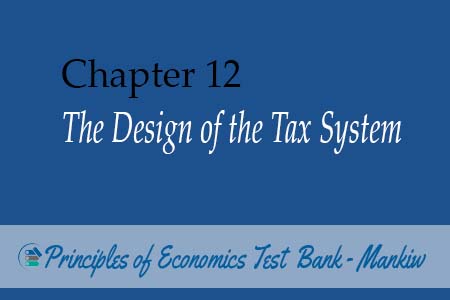
1. During what war
did government spending rise dramatically in the United States, and then never
again fall to its peacetime levels?
a. Civil War
b. World War I
c. World War II
d. Vietnam War
2. Which type of tax
is used to finance the Social Security program in the United States?
a. consumption tax
b. income tax
c. payroll tax
d. property tax
3. All of the
following are transfer payments except
a. Medicaid.
b. unemployment compensation.
c. personal income taxes.
d. food stamps.
4. If Nebraska
imposed a tax on milk of 10 cents per gallon,
a. this is an excise tax.
b. this is an income tax.
c. tax revenue will fall.
d. the supply of milk will rise.
5. If either supply
or demand is perfectly inelastic, then the deadweight social loss from a tax is
a. infinite.
b. large.
c. small.
d. zero.
6. The deadweight
loss from a tax increases as supply becomes more __________ or as demand
becomes more __________.
a. inelastic; inelastic
b. inelastic; elastic
c. elastic; elastic
d. elastic; inelastic
7. Minimizing the
total deadweight loss from taxes that raise a certain amount of revenue for the
government is known as
a. an external benefit.
b. optimal taxation.
c. a lump-sum tax scheme.
d. horizontal equity.
8. In the short run,
the imposition of a payroll tax of $1 per labor hour will have which of the
following effects?
a. The quantity of labor exchanged will fall.
b. The after-tax wage received by workers will fall.
c. The quantity of labor traded will become inefficient.
d. All of the above are correct.
9. A person’s tax
obligation divided by her income is called her
a. marginal social tax rate.
b. marginal private tax rate.
c. marginal tax rate.
d. average tax rate.
10. A person’s
average tax rate equals her
a. tax obligation divided by her marginal tax rate.
b. increase in taxes if her income were to rise by $1.
c. tax obligation divided by her income.
d. increase in taxes if her marginal tax rate were to rise
1%.
11. A person’s
marginal tax rate equals
a. her tax obligation divided by her average tax rate.
b. the increase in taxes she would pay as a percentage of
the rise in her income.
c. her tax obligation divided by her income.
d. the increase in taxes if her average tax rate were to
rise 1%.
12. Pat figures that
for every extra dollar she earns, she owes the government 33 cents. Her total
income now is $35,000, on which she pays taxes of $7,000. Her average tax rate
is __________ and her marginal tax rate is __________.
a. 33%; 20%
b. 20%; 33%
c. 20%; 20%
d. 33%; 33%
13. Horizontal equity
in taxation refers to the idea that people
a. in unequal conditions should be treated differently.
b. in equal conditions should pay equal taxes.
c. should be taxed according to their ability to pay.
d. should receive government benefits according to how much they
have been taxed.
14. The idea that
people in equal conditions should pay equal taxes is referred to as
a. horizontal equity.
b. vertical equity.
c. diagonal equity.
d. linear equity.
15. Vertical equity
in taxation refers to the idea that people
a. in unequal conditions should be treated differently.
b. in equal conditions should pay equal taxes.
c. should be taxed according to their age and experience.
d. should receive government benefits according to how much
they have been taxed.
16. A tax that is
higher for men than for women violates the criterion of
a. diagonal equity.
b. linear equity.
c. vertical equity.
d. horizontal equity.
17. The benefits
principle of taxation is LEAST characteristic in
a. Social Security taxes.
b. gasoline taxes.
c. taxes on airline tickets.
d. tolls used to finance the construction of a bridge.
18. A tax is
__________ if it takes a constant fraction of income as income rises.
a. regressive
b. proportional
c. progressive
d. aggressive
19. A tax is
__________ if it takes a smaller fraction of income as income rises.
a. regressive
b. proportional
c. progressive
d. aggressive
20. Most economists
argue that when federal, state, and local taxes are combined, the overall
effect is
a. proportional.
b. progressive.
c. regressive.
d. unfair.
21. In its purest
form, a __________ system would eliminate the existing array of different tax
rates on personal income and replace them with a single tax.
a. value-added tax
b. consumption tax
c. sales tax
d. flat-rate income tax
22. The main
arguments in favor of a modified flat-rate tax system (such as a proposal to
place a 19% tax on all income over $20,000 with no deductions) are it would
a. raise more revenue than the current tax system, and it
would be simpler.
b. raise more revenue than the current tax system, and it
would lower marginal tax rates.
c. be simpler and it would lower average tax rates.
d. be simpler and it would lower marginal tax rates.
23. If the government
imposed a $1,000 tax on every individual,
a. this would be an equitable tax.
b. allocative efficiency would have to be sacrificed.
c. this would be an efficient tax.
d. this would be an income tax.
24. In choosing the
form of a tax, there is a trade-off between
a. allocative and productive efficiency.
b. profits and revenues.
c. efficiency and fairness.
d. fairness and profits.
25. If society is
interested in devising a tax that is fair to its citizens,
a. the tax will raise efficiency.
b. none can be devised.
c. the tax will create inefficiencies.
d. it should choose a lump-sum tax.
No comments